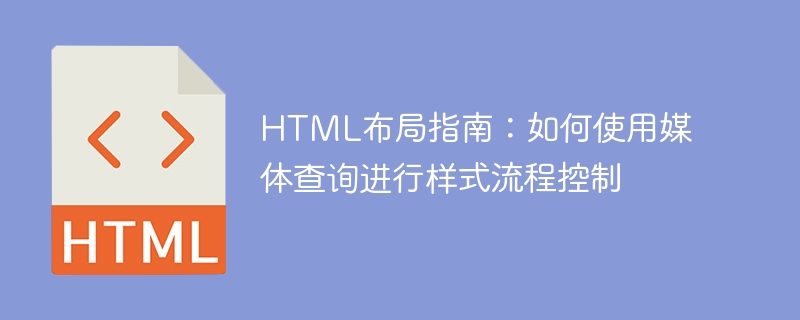Home >Web Front-end >HTML Tutorial >HTML layout guide: How to use media queries for style flow control
HTML layout guide: How to use media queries for style flow control
- WBOYWBOYWBOYWBOYWBOYWBOYWBOYWBOYWBOYWBOYWBOYWBOYWBOriginal
- 2023-10-20 09:39:30975browse

HTML Layout Guide: How to use media queries for style flow control, with code examples
Introduction:
In modern web design, responsiveness Layout has become an important factor that cannot be ignored. Responsive layout allows web pages to adapt to different devices, providing users with a better browsing experience. Media queries are one of the key tools for implementing responsive layout. This article will introduce the concept, syntax and common application scenarios of media queries, and provide code examples to facilitate readers' understanding and application.
1. What is media inquiry?
Media Queries (Media Queries) is a module in CSS3 that allows us to apply different styles based on different media types, viewport sizes, device characteristics and other conditions. Through media queries, we can change the layout and style of our web pages based on conditions such as the device's screen size, resolution, or device orientation.
2. The syntax of media query
In CSS, the syntax of media query is as follows:
@media mediatype and (mediafeature){
/* 样式规则 */
}
mediatype is the media type, which can be all (all devices), print (printing device), screen (screen device), speech (speech synthesis device), etc. mediafeature is the conditional feature to be detected, such as width (viewport width), height (viewport height), device-width (device width), etc. Place the conditions to be matched in parentheses, you can use logical operators and, not, only, etc.
3. Application scenarios of media queries
- Screen size adaptation
The most common use of media queries is to adjust web page layout according to different screen sizes. For example, we can provide a wider layout and font size for large screen devices, while displaying a compact layout and smaller font size for small screen devices.
<style>
@media screen and (max-width: 768px){
/* 在宽度小于或等于768px的屏幕上应用的样式规则 */
}
</style>- Image and media adaptation
Displaying images of different sizes on different devices is one of the important means to improve web page performance. Through media queries, we can adjust the display size and resolution of the image according to the device screen size.
<style>
@media screen and (max-width: 768px){
.image{
background-image: url(small-image.jpg);
}
}
@media screen and (min-width: 769px){
.image{
background-image: url(large-image.jpg);
}
}
</style>- Device orientation adaptation
On mobile devices, users may switch between landscape and portrait orientation. Through media queries, we can change the layout and style of the web page according to the device orientation.
<style>
@media screen and (orientation: portrait){
/* 在竖屏时应用的样式规则 */
}
@media screen and (orientation: landscape){
/* 在横屏时应用的样式规则 */
}
</style>- Print style control
When printing, we may need to adjust the layout and style of the web page to fit the printing paper. Through media queries, we can specify specific styles for the printing device to ensure better printing results.
<style>
@media print{
/* 打印时应用的样式规则 */
}
</style>4. Summary
Media query is an important tool for implementing responsive layout, which allows us to apply different styles according to different devices and conditions. This article introduces the concept, syntax, and common application scenarios of media queries, and provides code examples to facilitate readers' practical application. By mastering the knowledge of media queries, we can easily implement web page layouts that adapt to different devices and conditions, providing a better user experience.
(See attachment for H5 code)
The above is the detailed content of HTML layout guide: How to use media queries for style flow control. For more information, please follow other related articles on the PHP Chinese website!

